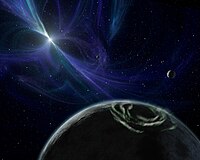
Photo from wikipedia
We investigate effects of energetic pulsar wind nebulae (PWNe) on dust formation and evolution. Dust emission has been observed in many supernova remnants that also have neutron stars as compact… Click to show full abstract
We investigate effects of energetic pulsar wind nebulae (PWNe) on dust formation and evolution. Dust emission has been observed in many supernova remnants that also have neutron stars as compact remnants. We study the dependence of dust formation time and size on properties of the ejecta and central pulsar. We find that a pulsar with an initial spin period $P \sim 1\mbox{-}10\,\rm ms$ and a dipole magnetic field $B \sim 10^{12\mbox{-}15}\,\rm G$ can either accelerate or delay dust formation, with a timescale of several months to over ten years, and reduce the average size of dust by a factor of $\sim$ 10 or more compared to the non-pulsar case. We also find that infrared dust emission may be detectable in typical superluminous supernovae out to $\sim$ 100-1000 Mpc in 2-5 years after the explosion, although this depends sensitively on the spectral index of nonthermal emission from the nebula. We discuss implications to previous supernova observations. Some discrepancies between dust formation models and observations, such as the formation time in SN1987A or the dust size in the Crab Nebula, could be explained by the influence of a pulsar, and knowledge of the dust emission will be important for future ALMA observations of superluminous supernovae.
Journal Title: Monthly Notices of the Royal Astronomical Society
Year Published: 2019
Link to full text (if available)
Share on Social Media: Sign Up to like & get
recommendations!